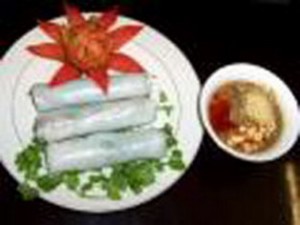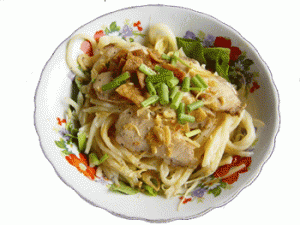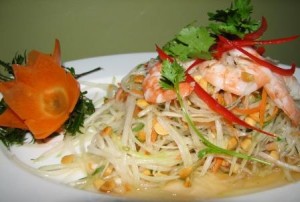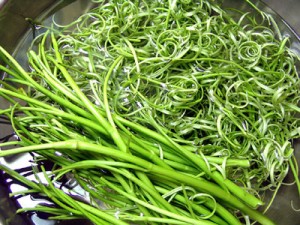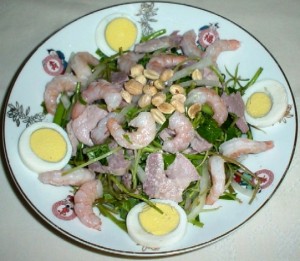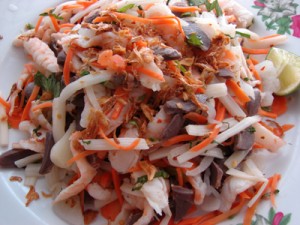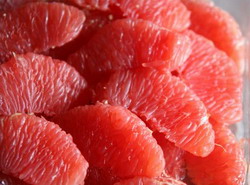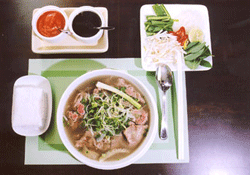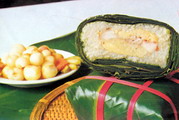| http://www.dreamvietnamtravel.com/restaurant.asp |
Steamed Bun (Bánh bao) 
Steamed bun dumpling that can be stuffed with onion, mushrooms, vegetables, etc. Banh bao is an adaptation from the Chinese baozi to fit Vietnamese taste. Exclusively vegetable banh bao are also available. Vegetarian banh bao are popular food in Buddhist temples. Typical stuffing for banh bao include slices of marinated “xa xíu” (from Chinese cooking) meat, tiny boiled duck eggs or quail eggs, and pork. Recipes- 1/2h prepare- 30- 40 buns Ingredient: Dough 4 cups self-rising flour Filling 2 links Chinese sausage, thinly sliced How to cook 1. Submerge mushroom in hot water until softened. Take them out, dry and finely julienne. Reserve water.
Banh beo xu Hue (Hue Bloating Fern-Shaped Cake) Banh beo is a specialty and indispensable in Hue City. Banh beo is delicious with its core stuffed with small shrimps and sauce made from a mixture of fish sauce, sugar, garlic, chilly and fresh small shrimps, watery grease. Therefore, it offers customers with sweet, buttery and smelling flavors. Without delicious sauce, the cake would become worthless. When serving, it is required to use a tool called Que Cheo (bamboo folk) to pass through the cake, cut into pieces, prick and eat. Customers would be impressed forever with having Banh beo in a green garden while listening to Hue folk song coming from the Perfume River. Recipes: Hue bloating fren-shaped cake with shrimp and scallion oil (bánh bèo man) Makes 32 pancakes, serves 4 as a starter For scallion oil: 2 scallions, white and green parts, thinly sliced ( 1/2 cup) For batter: 1 cup rice flour, any Thai brand from an Asian market (Note: Do not use glutinous rice flour) For shrimp topping: 1/3 pound medium shrimp, peeled and deveined For sauce: 2 tablespoons sugar To make scallion oil: Have scallions ready in a small bowl so they may be quickly added to the oil. In small saucepan, heat oil over medium heat until hot. To test, drop in a scallion slice; it should sizzle on contact. Add scallions and stir immediately to expose them quickly to the oil. When scallions have collapsed and are soft, after about 30 seconds, remove from heat. Transfer scallions and oil to a small heat-proof bowl and let cool completely. The garnish will keep for several hours at room temperature. Or, cover and refrigerate for up to 7 days, then bring to room temperature before using. Makes about 1/4 cup. To make batter: In a bowl, stir together rice flour, cornstarch and salt. Make a well in the center, pour oil and water into the well, and whisk together to produce a thin, smooth batter. You should have about 2 cups batter. Let batter rest for 30 minutes. To make topping: In small saucepan, combine shrimp and salt with water just to cover and bring to boil over medium heat. Cook about 8 minutes, or until all water has evaporated. (This intensifies flavor of shrimp.) Transfer shrimp to small bowl and set aside to cool for 10 minutes. Transfer shrimp to a mini food processor and process to a minced, fluffy texture. Or mince by hand using a knife. Return shrimp to bowl. In small non-stick skillet, heat oil over medium heat. Add shallot and saute about 1 minute, or until fragrant. Add shrimp and stir to combine. Sprinkle in sugar, pepper and fish sauce. Continue to cook, stirring, 3 to 4 minutes to dry shrimp, lowering heat when bits of shrimp pop. Shrimp are done when they look crumbly and are brilliant orange. Transfer to bowl and set aside until ready to use. (Shrimp may be prepared up 3 days in advance, cooled, covered, and refrigerated. Bring to room temperature before using.) To make sauce: In a small bowl, combine sugar, vinegar, water and fish sauce and stir to dissolve sugar. Taste and make any adjustments to create a light, slightly sweet sauce. Add chili and set aside until serving time. To cook pancakes: Fill bottom section of steamer halfway with water and place steamer tray on top. Bring water to rolling boil over high heat. Nearby have ready the batter, a ladle, a small knife or metal spatula and serving plates for holding the pancakes. Make pancakes in batches. Have ready about 8 small dishes, each about 2 1/2 inches wide and at least 1/2 inch deep. Put dishes into steamer tray, placing them away from the edge where condensation collects. So that batter will set quickly, cover steamer and let dishes preheat for 2 minutes. Remove lid carefully. Do not let condensation drip into the dishes. Ladle batter to a depth of 1/4 inch into each dish (about 1 tablespoon batter.) Replace lid and steam 3 minutes, or until pancakes are shiny and firm and have a shallow indentation in center. Reduce heat to low and wait for steam to subside before lifting lid, and then lift it away from you carefully to avoid condensation dripping onto the pancakes. Use metal tongs to transfer dishes to counter. Let pancakes cool 2 minutes. They will firm up slightly. To unmold: Dip tip of knife (or spatula) in water and run it along edge of a pancake to loosen it. Use your fingers to gently pry pancake from dish, and then place it on a serving plate. Repeat until you have unmolded all the pancakes. The finished pancakes resemble tiny white plates. Return steamer to a boil over high heat. Give the dishes a quick rinse and wipe before returning them to the steamer tray for another batch. Repeat until all batter is used. (Cooled pancakes may be covered with plastic wrap and kept at room temperature up to 8 hours.) To serve: Fill indentation of each pancake with a generous 1/2 teaspoon of shrimp topping and dot with a generous 1/4 teaspoon of scallion oil garnish. Serve with the sauce. The best strategy for eating the pancakes is to use chopsticks to scoot one onto a soup spoon and then drizzle on some sauce. From Andrea Nguyen of Santa Cruz, whose first cookbook, “Into the Vietnamese Kitchen: Treasured Foodways, Modern Flavors,” will be published in October by Ten Speed Press
Banh Chung and Banh Tet (Boiled Rice and Pork Cakes) Boiled rice and pork cakes are usually cooked 2-3 days before Tet. Both can be kept for about two weeks in cool temperature. However, after this time they become hard and must be re-boiled. Soak some green beans overnight in water to soften. Drain, rub and clean to remove the skin, and leave to dry. Next, cook the beans in a steamer and grind. Form into balls the size of tennis balls. Soak some glutinous rice overnight. Clean and rinse. Mix with a little salt. Cut fresh pork meat (lean or fat, according to personal taste) into 2cm strips. Mix with salt, fish sauce and pepper, and leave for about one hour. Clean dong leaves (leaves from arrowroot) and place them over each other to form a cross. Place an amount of rice in the centre of the leaves. Shape into a square (the southern version is in a circle). Press a “ball” of green bean on top. Then, add 1-2 pieces of marinated pork, then more green bean, and finally rice. Press firmly into a compact square and wrap the leaves over to cover the cake completely. Tie with bamboo strings. Place in a large pot of boiling water and boil overnight. Squeeze the moisture out by placing it in a colander with a heavy object on top. To serve, untie and open the leaves. Invert on a plate and cut into pieces using the bamboo strings, not a knife. Serve cold.
Banh Cuon (Rolled Rice Pancake) Banh cuon is popular to Vietnamese as disk for breakfast. The cake preparing process includes grilled rice which is steamed and oil-spread to have sweet-smelling. Banh cuon is prepared available. Leaves of cake put on plate as the customers ask for the disk. The cake is called Banh cuon Thanh Tri due to its origin is Thanh Tri Village of South Hanoi. Besides Banh cuon Thanh Tri, there is rolled rice pancake with the filling of the cake is made from minced pork mixed with Jew’s ears and thin-top mushrooms. The cake, placed on plate, serve with salted shredded shrimp and fried dry onions. The customers immediately experience the disk as it is just finished and still very hot. It is the sauce of the cake that fascinates the customers. The cake-makers have their own know-how, some of them prepare Banh cuon with Belostomatid essence to have sweet -smelling to attract to the customers.
Banh la cha tom (Grilled Rice Cake with Cray Fish) Anyone who used to experience the dish would never forget such simple cake made from grilled rice cake and Cray fish only. The cake must be as thin as a leaf but flexible enough. Cray fish must be brittle and sweet. Serving with long jawed anchovy sauce. Banh la cha tom does not as heavily smell as the majority of the other dishes but gentle, elegant and attractive to customers
Bánh mì kẹp thịt (Vietnamese Sandwich) Bánh mì kẹp thịt, Vietnamese Sandwich, French bread containing paté, Vietnamese mayo, different selections of Vietnamese cold cuts and deli (a large variety, most commonly with ham, head cheese, and a Vietnamese bologna), pickled daikon and carrot, cucumber slices. Often garnished with coriander, black pepper, and jalapeño pepper (optional). This food is common everywhere in Vietnam as a favorite of factory workers and school kids and eaten for any meal of the day, commonly breakfast and lunch. There are a wide variety of banh mi (with different meats) and many shops have popped up across North America serving primarily Banh mi. The most popular Banh Mi include:
Recipes Ingredients 1 teaspoon five-spice powder How to cook 1. In an 8- 10 inch saute pan over medium/high heat, stir five spice until fragrant, about 30 seconds.
Banh tom Ho Tay (Ho Tay Fried Shirmp Cake) All people who used to live in Hanoi are familiar with Banh tom Ho Tay Restaurant on the Thanh Nien (Young) Street. The cake preparing process includes wheat flour mixed with potato fibers, placing on shape with shrimps upper, then fried with oil. The cake is brittle, soft, sweet-smelling, and served with vegetable pickles and sweet and sour fish sauce for best taste.
Banh trang cuon thit heo (Dry Pancake Roll with Pork) Coming to the Central region, you are offered with the service of Banh trang cuon thịt heo. A big plate of fresh vegetables with a peppery-hot red chili, a plate of boiled lean and fat meat, a bowl of fish sauce, and a plate of dry pancakes are displayed on the dining table. Customers have to serve themselves with all of the 10 substances mentioned above. Banh trang cuon thịt heo is considered as not only a daily dish but also likely an artistic specialty of the Central citizens. Recipes Ingredients: How to cook Step 1: Combine lemongrass, sugar and fish sauce. Marinate beef in sauce mixture for 30 minutes, then briefly grill over a medium heat until lightly browned, but still rare inside. Remove from grill and cut into small pieces. Place some of the beef, a little of the mint, basil and lettuce leaves on a rice flour wrapper, then sprinkle with sesame seeds and add a cilantro leaf. Fold to the inside, leaving the top end open with the cilantro leaf extended.
Banh xeo (Vietnamese Crepe-Type Pancakes ) Bánh Xèo are Vietnamese crepe-type pancakes made out of rice flour and coconut milk(optional), and are pan-fried and stuffed with slivers of fatty pork, shrimp, and bean sprouts. Served wrapped with lettuce leaves and stuffed with mint (optional) and other herbs, and dipped in fish sauce. The recipe from Dinner Co-Op is as follows: Vietnamese Pancakes (Banh Xeo) Loan Ly Makes 10 pancakes 1 3/4 cups of rice flour How to cook In a medium bowl, whisk the rice flour together with 2 cups of water. Add turmeric and scallion and mix well. Set batter aside. (Can be kept in frig. for up to three days.)
Bun bo gio heo (Beef and Pork Soft Noodle Soup) Preparing Bun bo gio heo is very skillful. Pig leg is clean-shaved, chopped into even slices with adequate bone, meat and skin, mixed with lean beefs, and soaked with salt, pepper, fish sauce, dry onion and spices. Bun bo gio heo is proper with all appetites. Even diet people could enjoy the sweet-smelling of beef with less fat of pig leg so as not to be fed up with as serving. Bun bo gio heo is delicious anytime you have it. You could enjoy this specialty of the Central region on Hue City. For: 10 persons Ingredients: – 1kg pork leg To prepare: – Soak pork in salt, roll and tie with bamboo. To cook: – Bring to boil five litres of water, add lemon grass, chilli, beef, and pork and return to the boil. To serve:
Bun Thang (“Ladder” Soft Noodle Soup), Speacial Food In The North Dishes made of soft noodle soup are diverse such as vermicelli and fried chopped meat, Bun Thang, vermicelli and sour crab soup, stewed vermicelli and boiled lean meat, etc. The popular dish is vermicelli and sour crab soup whilst Bun Thang is for connoisseurs, unique and available in Hanoi only. A bowl of Bun Thang includes lean pork paste, thin fried egg, salted shredded shrimp, chicken, onion, shrimps paste, and a little Belostomatid essence. Especially, Bun Thang bouillon made from shrimps and meat must be very sweet and pure. Without enjoying Bun Thang when arriving to Hanoi, it somewhat seems to lack of a part of taste of Hanoi.
Ca Kho To (Dry-Boiled Catfish) Fish, which used to prepare for the dish, can be catfish, anabas or snake-head fish. Necessary spices include dry garlic, fresh lemon, onion, chilly, sugar, glutamate, fish sauce, grease, and a spoon of pepper and wine. Recipes Ingredients : Serves 4 1-1/2 pounds mackerel or eel, bone-in, about 1-inch-thick steaks coarse sea salt How to cook Season the fish steaks with salt and pepper on both sides. Make a caramel by combining the sugar and 2 tablespoons water in a large sand pot or heavy-bottomed pot over medium-low heat. When the sugar melts and turns golden, about 10 minutes, remove the pot from the heat and stir in 1/3 cup water, thick soy sauce, and fish sauce. Reduce the heat to low and add the daikon, garlic, scallions, chilies, and fish steaks. Cover and simmer until the fish is cooked through, about 20 minutes. Ca Nuong Trui (Bare Fried Fish) The Southern villagers in countryside areas usually have fried fish in the field. They use a bamboo piece to cross through the fish. Pitch the head side to ground, pile up rice straws at the wind-swept place to smoke fish. Recipes of Ca Nuong Trui Chay (Bare fried vegetable fish) Soya bean curd sauce ingredients: 1 Tablespoon olive oil * Available in Asian markets Directions: Soya bean curd sauce: 1. Preheat a medium saucepan on medium heat and add in the olive oil. Stir-fry the minced lemongrass until partially golden. Add the crushed pineapple and stir quickly. Shake up the bottle of wholegrain soy sauce and pour into a saucepan. Baking the vegetarian fish: 1. Preheat the oven to 400° F for 10 minutes. Coat the vegetarian fish with the soft butter or margarine and place it onto a baking dish. Put in the oven and bake for 10 to 15 minutes. Remove from oven. Spring roll wrapper: Dip the spring roll wrapper into warm water, and place on a big plate. Decoration: {Wrap the vegetarian fish, the lettuce leaves, and the fresh herbs with the spring roll wrapper. Dip into the soya bean curd sauce for zesty flavor.
Ca Tai Tuong Chien Xu (“Tai Tuong” Bloating Fried Fish) “Tai tuong” fish is classified as a kind of luxurious food-stuffs.
Cao Lau Hoi An (Hoi An Vermicelli) Cao lau as a dish has its “own kingdom”, therefore, customers are likely to be served with it only in Hoi An. Cao lau noodles are carefully made from local new rice not stocked one. Water used to soak rice must be taken from wells in the Ba Le Village; noodles thus will be soft, enduring and flavored with special sweet-smelling. In addition, meat used to prepare for Cao lau must be loin or trotter. Dry pancakes used must be thick and have much sesame. Greasy coconut quintessence and bitter green cabbage are also indispensable. The so-called genuine Cao lau Hoi An must satisfy all above requirements.
Cha Ca La Vong (La Vong Grilled Fish Pies) Cha ca La Vong is a unique specialty of Hanoi people, therefore one street in Hanoi was named as Cha Ca Street. Cha ca is made from mud-fish, snake-headed fish, but the best one is Hemibagrus (Ca lang). Fish bone is left away to keep fish meat only, then seasoning, clipping by pieces of bamboo, and frying by coal heat. An oven of coal heat is needed when serving to keep Cha ca always hot. Cha ca is served with roasted peanuts, dry pancakes, soft noodle soup, spice vegetables and shrimps paste with lemon and chilly. The Cha ca La Vong Restaurant on No.14 Cha Ca Street is the “ancestor restaurant” of the dish. Com (Grilled Green Rice) Every autumn, around September and October, when the cool north-westerly wind brings a cold dew, the sticky rice ears bend themselves into arches waiting for ripe grains because these rice grains are at their fullest and the rice-milk is already concentrated in the grains, predicting that the com season has arrived. Better than any other person, the peasant knows when the rice ears are ripe enough to be reaped to begin making com. Com is made from green sticky rice that is harvested in blossom period, roasted in many times, crashed and sieved. Com is a specialty; at the same time, it is very popular. One can enjoy com with tieu ripe banana. When eating com, you must eat slowly and chew very deliberately in order to appreciate all the scents, tastes, and plasticity of the young rice. Com is an ingredient also used in many specialties of Vietnam, including com xao (browned com), banh com (com cakes), che com (sweetened com soups), etc. Com may be obtained anywhere in the North of Vietnam, but the tastiest com is processed in Vong Village, 5km from Hanoi, where com making has been a professional skill for many generations.
Com Hen Song Huong (Perfume River Mussel Cooked Rice) Com hen has a sweet-smelling flavor of rice, onion, and grease, as well as strange tastes of sweet, buttery, salty, sour, bitter, and peppery-hot. You have to arrive to Hen river-islet in the Perfume River to have the original Com hen. However, you can find out the dish on some streets in Hue City. It requires 15 different raw materials to prepare for the dish, including mussel, fried grease, watery grease, peanuts, white sesames, dry pancake, salted shredded meat, chilly sauce, banana flower, banana trunk, sour carambola, spice vegetables, peppermint, salad, etc. Com hen is always attractive to many customers because it is tasty and, at the same time, economic to anybody
Cơm Tấm Cơm tấm is grilled pork (either ribs or shredded) plus a Vietnamese dish called bi (bì) (thinly shredded pork mixed with cooked and thinly shredded pork skin) over broken rice (what the words “com tam” actually mean in Vietnamese). The rice and meat are served with various greens and pickled vegetables, along with a prawn paste cake, trung hap (trứng hấp) (Vietnamese adaptation of Chinese Egg Foo Young), and grilled prawns. Typically restaurants will serve this popular combination rice plate with a small bowl of Nước chấm, as well as a small bowl of soup broth with spring onions (to cleanse the throat).
Cua Rang Muoi (Fried Salted Crabs) The Westerners, especially those in land-locked countries, usually appreciate the dish as soon as they firstly experience it. Ingredients : Serves 4 2: Crabs, about 1.5 kg Method: Clen crabs. Pull top shells off crabs and remove feathery lungs. Rinse.
Gỏi Cuốn (Summer Spring Roll)
Summer rolls or Spring rolls (Gỏi cuốn) also known as Vietnamese fresh rolls. Summer rolls are unfried wraps with pork, shrimp, herbs, rice vermicelli, and other ingredients wrapped in rice paper. Summer rolls are often confused with spring rolls, which are typically stuffed with pork/shrimp, cabbage, and bean thread vermicelli and are always fried. Summer rolls are normally dipped in a simple sauce consisting of hoisin sauce, garlic, peanut butter, and water which are boiled until well blended. Spring rolls almost constitute an entire category of Vietnamese foods, as there are numerous different kinds of spring rolls with different ingredients in them
Gio Lua (Silky Lean Meat Paste) By itself, the name “silky lean meat paste” evokes thoughts of the silky aspect of this speciality. Gio lua is made with lean pig meat, which is pounded with a pestle until it becomes a sticky paste. Fresh banana leaves are tied very tightly around the paste, and then it is well cooked. Good gio lua has a fine white colour, is firm, and has a perfumed and sweetish taste. Gio lua may be obtained anywhere in Vietnam, but the best gio lua is from Uoc Le Village (Hanoi), where the know-how for Gio lua is strictly kept so as to allow no secrets of the job to flow out from Uoc Le. Slices of Gio lua are slightly pink, moist, and sweet-smelling meat, fish sauce and banana leaf.
Goi (Vietnamese Salad Recipes) Salads are popular in Vietnam. Simple combinations such as cooked chicken and shredded cabbage are given an exotic touch by the addition of chopped mint and fresh coriander leaves and the inevitable nuoc mam sauce or nuoc cham, used as a dressing. Vietnamese food includes a lot of fresh, uncooked vegetables and fruit, and food is cooked in water rather than oil – two reasons why a Vietnamese meal does not bring on a feeling of surfei Many varieties with the most popular including: Recipes Of Green Papaya Salad Green papaya salad is one of Vietnam’s favorite salads which is not very difficult to make. This dish is really colorful, tasty and healthy – good for vegetarians as well. Ingredients: Green Papaya: 300g Vietnamese Mint(Rau Răm): 10g Peanut: 30g How To Make:
Recipes Of Water Spinach Salad- (Vietnamese Dish) Ingredients: 1 bunch of water spinach (select big stems) Preparation: Cooking: Recipes Of Lotus Stem Salad 1 tablespoon: Salad dressing 1 tablespoon: Mixed fish sauce Salad Garnishing Method : Goi Buoi (Salad Of Shaddock) Goi buoi is available at the majority of famous restaurants in Ho Chi Minh City. The major substances to prepare for the dish include shaddock mixed with fresh shrimps, pork, and dry cuttle-fish. The dish is originated in Miet Buoi, Bien Hoa City. Goi buoi dish is especially flavored with slightly sour, sweet, peppery-hot and buttery tastes. It is also added with spice vegetable, white sesames, coconut and dry cuttle-fish. Therefore, the dish will be appeared on dining table as a fresh colorful picture and attractive to customers.
Lau Mam (Mixed Vegetable And Meat Hot Pot) At present, Lau mam folk dish in the past hundred years – become a luxurious specialty in the South. Chau Doc fish sauce made from fresh-water fish, a kind of sweet- smelling and greasy fish, which must be as required to have a delicious Lau mam dish. Substances to prepare for Lau mam, including fresh food-stuffs such as snake-head fish, “keo” fish, pork, peeled shrimps, eel, beef, and so on, accompanied with at least 10 kinds of vegetable, sometime amounting to 24 kinds of vegetable. They include water-lily, egg-plant, balsam-apple, straw mushroom, bean sprouts, chilly, etc. When boiled, the flavors of the sauce, which is mixed with citronella, chilly, vegetables, fish, shrimp and meat, are very sweet-smelling. Lau mam roam is scoop out into bowls and served with soft noodle soup, simply but deliciously.
Lon Quay Lang Son (Lang Son Roasted Pork) Anyone who arrives in Lang Son Province could find it difficult to say no to Lon quay dish. Lon quay Lang Son is delicious for many reasons, however, the main specific taste of the dish comes from the unique flavor of a kind of leaf called “Mac mat” (meaning “sweet leaf”). The leaf is soaked with spices, fish sauce, glutamate, flavoring powder, then stuffed into clean pig belly and placed on reverted furnace. Pig is fried the spread with watery honey so as to make the skin turn golden and brittle, and pork is soft and sweet-smelling as finish.
Mon Oc (Snail Dish), Special Food In The North Snail dish is a popular but unique dish of Hanoi people. It is easy to order some dishes like snail steamed with ginger leaf, gingered snail, snail sauted with carambola, snail boiled with lemon leaf, snail steamed with Chinese herbs, and so on, in many small restaurants, restaurants, and even hotels. However, vermicelli and snail sour soup is the most attractive to young ladies because of brittleness by snails, the slightly sour taste by snail soup, and hot by chilly boiled down, making even gorged people keep eating.
My Quang (Quang Soft Noodle Soup) Similar to rice noodle and chicken or pork soup (Hu tieu), My Quang is a variety of Pho (rice noodle soup), because the noodles are made from rice and soused with soup as serving. The soup sauce, which is added, comes from a mixture of flavor from beef or pork bone, shrimps, crabs, chicken and duck. The noodles are yellow, somewhat distinct from Pho Similar to rice noodle and chicken or pork soup (Hu tieu), My Quang is a variety of Pho (rice noodle soup), because the noodles are made from rice and soused with soup as serving. The soup sauce, which is added, comes from a mixture of flavor from beef or pork bone, shrimps, crabs, chicken and duck. The noodles are yellow, somewhat distinct from Pho. However, the main reason for having this color is to be in hannony with the colors of shrimps and crabs. There is also noodle for vegetarians. Quang soft noodle soup tastes best when being served with a variety of herbs, such as mint leaves, houttunya, cabbage, onion, coriander, banana flower and so on. A bowl of Quang soft noodle soup is normally dressed with pieces of banh trang (also called baked rice paper), roasted groundnuts, shrimp or pork, which look very tasty. Coming Quang Nam, you are easy to see many Quang noodle small restaurants along 1A National Road always crowded such as Binh Nguyen chicken noodle (Thang Binh district), Ky Ly chicken noodle (Tam Ky town), Cay Tram shrimp noodle (Nui Thanh province), Cam Ha beef noodle (Hoi An town)… The Best My Quang Is Made From Rice In Phu Chiem, Shrimp In Cho Dai And Spicy Vegetables In Tra Que. As A Strict Selection Of Substances To Prepare, My Quang Has Been Dominant In Almost All Of Culinary Markets In The Central Provinces And Expanded To Ho Chi Minh City With A High Qualification Of A Quang Ngai’s Specialty.
Nem Chua (Pickled Sour Pork Sausage) Nem chua is a Vietnamese cured pork sausage, available from Oriental stores. Very common food in Vietnam, rolling around by banana leaf. Most favorist in Thanh Hoa province. Recipes of Nem chua 1 pound pork loin, sliced Method
Pho (Rice Noodle Soup) Pho, a typical dish of Hanoi people, has been existing for a long-time. Pho is prepared not only in a sophisticated manner but also in the technique which is required to have sweet but pure bouillon, soft but not crashed noodle, soft and sweet-smelling meat. Ingredients for 06 pax 2 oz (60g) dried rice stick noodles How to cook Variations: Use thinly sliced firm tofu or smoked salmon instead of beef. Tips: To help cut the beef into paper-thin slices, place the meat in the freezer for about 30 minutes to firm up before slicing with a very sharp knife.
Tet Food Vietnam is a country in the Eastern Hemisphere that was influenced by China for many years. Therefore, the Chinese New Year and Tet, the Vietnamese New Year have many similarities. Tet is the abbreviation of Tet Nguyen Dan which means the first morning of the first day of the new period. Tet marks the beginning of a new year on the lunar calendar, and the beginning of Spring. Vietnamese are constantly aware of the phases of the moon. All events are planned by the lunar calendar. The New Year begins on the first night of the first moon after the sun enters Aquarius. This is sometime between January 21 and February 19 on the solar calendar. Tet is a huge celebration lasting three days. Families save money, store food, and plan far in advance for Tet, major holiday in Vietnam. The Vietnamese take extreme care to start the New Year out right. They buy new clothes, paint and clean their homes, cook three days worth of food, pay off all debts and make amends to rid themselves of all bad feelings. Cleaning is frowned on during Tet because one would not want to sweep out any good luck. Digging and drawing water is also not allowed so the ground and water can enjoy the holiday. Food plays a major role in the Tet celebration. Tet is a time of excess, one does not enjoy Tet, one “eats” Tet. The first day a feast of boiled male virgin chicken, sticky rice, a special soup made with clear vermicelli and bamboo shoots, boiled pork, and 3 or 5 duck eggs is offered to ancestors who have returned to their homes. Sticky rice and salt are also offered in the streets to any hungry ghosts who might be wandering in the neighborhood. A traditional food is Earth cake, a square cake made with rice beans and pork. When a watermelon is cut they believe that the redder the watermelon the more luck for the family. Several different desserts and dishes are made with coconut. On the third day another feast of virgin chicken is served to say farewell to ancestors returning to their ethereal abodes. Canh mang (Dried bamboo Shoot Soup) Soak dried bamboo shoots in water for 2-3 days to soften. Boil 2-3 times if necessary. Cut into 5cm strips. Fry with pig trotters and salt. Add water, bring to boil and simmer until meat is tender. Garnish with green onion. Bong (Dried Pig Skin) Soak dried pig skin (the skin should be yellow, which means it has been pre-treated) in water for one hour. Drain and then add a cup of rice whisky and fresh ginger. Rub onto the skin (this will remove the smell). Cut into diamond-shaped pieces. To make fresh chicken stock, add dried shrimps and dried huong (perfume) mushrooms, which have been pre-soaked in warm water, to 2-3 chicken carcasses. Bring to boil and simmer. Remove the dried mushrooms. Cut carrot and kohlrabi into decorative shapes (flowers, leaves etc). Boil the dried pork skin in the chicken stock for several minutes until tender. Add French/ string beans. To serve, mix all drained ingredients (place vegetables on top) and garnish with coriander. Hanh muoi (Pickled Onions) Mien (Vermicelli Noodles) Cut mien into lengths and pre-soak for 10-15 minutes in water. Boil chicken innards (liver, heart, etc), salt and green onions in a fresh chicken stock. Mix with mien and serve. Moc (Pork Soup) Buy raw minced pork. Add dried mushrooms, which have been soaked to be softened. Mound pork on the mushrooms and boil in chicken stock. Ga ran or luoc (Fried or Boiled Chicken) Fried version: marinate raw chicken in salt, sugar, garlic, fish sauce and burnt sugar. Fry chicken and marinade in oil. Ca chep kho rieng (Carp with Galangal) Scale carp, cut into steaks and fry. Add finely sliced galangal, fish sauce, salt, burnt sugar and water (this makes the fish turn dark brown). Cook over a low heat until the fish is hard and little liquid remains. Bo kho que (Beef with cinnamon) Tie up beef muscle firmly with several strips of bamboo. Break cinnamon into small pieces, rub into beef. Sear. Xoi gac (Steamed Momordica Glutinous Rice) Soak glutinous rice in water overnight. Drain. Cut open the momordica (qua gac). Remove flesh and large black/red seeds. Mix this with a small cup of rice alcohol. Mix rice with salt and qua gac mixture. Steam in a rice steamer. During steaming, add some chicken fat and stir through. When steamed, add a little sugar and stir through with chopsticks. Mound onto a plate and decorate with the black seeds from the fruit. Che kho (Soft Green Bean Cake) Soak green beans in water overnight to soften. Rub and remove skin. Drain. Cook in boiling water until soft. Drain and grind into a wet powder. Mix with sugar in a pan over a medium heat. Keep stirring until a little drier and smoother. Place in a mound and invert onto a plate. Sprinkle with sesame seeds. To serve, cut into slices like a cake. Mut (Preserved Fruit) Prepare a week before Tet. The most important thing is to maintain the shape of the fruit. Use apple, potato, tomato, plum, ginger, mandarin, or gourd. Apple: Pierce skin lengthwise, but don’t cut too deep. Place in a bowl of cold water and lime. Soak overnight. Wash carefully and dry. Cover in red sugar. Stir very carefully in a dry pan over low heat until sugar melts and solidifies. Take off heat. Press down carefully on top of apple to make into shape evocative of a seashell. If using a kumquat, a traditional Tet fruit, use white sugar to keep the natural orange colour of the fruit. You must also keep the stalk in to keep the shape. You must also carefully press juice out after piercing skin. Last, but not least After indulging in all the above, remember that you cannot throw out any leftovers until the fourth day of Tet. It would also be highly inauspicious to sweep the rubbish from the house as all the good luck you have been working hard at will disappear with it.
Xoi Chien Phong (Bloating Fried Sticky Rice) A round plate of Xoi chien phong, placed next to a plate of buttery roasted chicken, is always attractive to anyone. A lump of sticky rice will become a plate of Xoi chien phong as big as a grape-fruit by talent chefs. In the past, Xoi chien phong was offered only in the Binh Duong Restaurant, Dong Nai Province. At present, you can taste the dish in star classified hotels in Ho Chi Minh City.
|
Janna's Vietnam Information
Support for Art and Culture in Vietnam

















